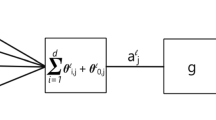Abstract
In many Signal Processing applications, data sampled by sensors comprise a mixture of signals from different sources. The problem of blind separation lies in the reconstruction of sources from the mixtures. In this paper a new method is proposed for the separation of sources, based on geometrical considerations. After a brief introduction, we present the principles of the new method and provide a description of the algorithm and map this on an artificial neural network. Finally we give examples with synthetic and real signals to illustrate the efficiency and utility of the network.
Similar content being viewed by others
References
C. Jutten, J. Hérault, P. Comon, E. Sorouchiary. Blind separation of sources, Parts I, II and III,Signal Processing, vol. 24, no. 1, pp. 1–29, July 1991.
L.H. Nguyen Thi, C. Jutten, J. Caelen. Speech enhancement: Analysis and comparison of methods on various real situations,Proceedings of EUSIPCO-92, Brussels (Belgium), pp. 303–306, August 24–27, 1992.
J. Hérault, C. Jutten, B. Ans. Detection de grandeurs primitives dans un message composite par une architecture de calcul neuro-mimétique en apprentissage non supervisé.10th GRETSI, Nice, France, pp. 1017–1022, 1985.
J.-F. Cardoso. Super-symmetric decomposition of the fourth-order cumulant tensor, blind identification of more sources than sensors,Proc. International Conf. Acoust. Speech Signal Process ’91, 14–17 May 1991.
P. Comon. Separation of sources using high-order cumulants,SPIE Conference on Advanced Algorithms and Architectures for Signal Processing, San Diego, California, vol. Real-time Signal Processing XII, pp. 170–181, August 8–10, 1989.
J.-L. Lacoume, P. Ruiz. Sources identification: A solution based on the cumulants,Proceedings of the 4th ASSP Workshop on Spectral Estimation and Modelling.Minneapolis, USA, pp. 199–203, August 1988.
M. Gaeta, J.-L. Lacoume. Source separation without a priori knowledge: the maximum likelihood solution,Proc. EUSIPCO’90, Barcelona (Spain), pp. 621–624.
N. Delfosse, P. Loubaton. Separation adaptive de sources independants par une approche de deflation,Proc. of 14-th GRETSI, Juan les Pins (France), vol. 1, September 1993.
C.G. Puntonet, A. Mansour, C. Jutten. A geometrical algorithm for blind separation of sources,Proc. of 15-th Colloque Gretsi, Juan les Pins (France), September 1995.
Author information
Authors and Affiliations
Rights and permissions
About this article
Cite this article
Puntonet, C.G., Prieto, A. An adaptive geometrical procedure for blind separation of sources. Neural Process Lett 2, 23–27 (1995). https://doi.org/10.1007/BF02332162
Issue Date:
DOI: https://doi.org/10.1007/BF02332162




